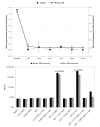Inactivation of HIV-1 in breast milk by treatment with the alkyl sulfate microbicide sodium dodecyl sulfate (SDS)
- PMID: 15888210
- PMCID: PMC1097759
- DOI: 10.1186/1742-4690-2-28
Inactivation of HIV-1 in breast milk by treatment with the alkyl sulfate microbicide sodium dodecyl sulfate (SDS)
Abstract
Background: Reducing transmission of HIV-1 through breast milk is needed to help decrease the burden of pediatric HIV/AIDS in society. We have previously reported that alkyl sulfates (i.e., sodium dodecyl sulfate, SDS) are microbicidal against HIV-1 at low concentrations, are biodegradable, have little/no toxicity and are inexpensive. Therefore, they may be used for treatment of HIV-1 infected breast milk. In this report, human milk was artificially infected by adding to it HIV-1 (cell-free or cell-associated) and treated with <or=1% SDS (<or=10 mg/ml). Microbicidal treatment was at 37 degrees C or room temperature for 10 min. SDS removal was performed with a commercially available resin. Infectivity of HIV-1 and HIV-1 load in breast milk were determined after treatment.
Results: SDS (>or=0.1%) was virucidal against cell-free and cell-associated HIV-1 in breast milk. SDS could be substantially removed from breast milk, without recovery of viral infectivity. Viral load in artificially infected milk was reduced to undetectable levels after treatment with 0.1% SDS. SDS was virucidal against HIV-1 in human milk and could be removed from breast milk if necessary. Milk was not infectious after SDS removal.
Conclusion: The proposed treatment concentrations are within reported safe limits for ingestion of SDS by children of 1 g/kg/day. Therefore, use of alkyl sulfate microbicides, such as SDS, to treat HIV1-infected breast milk may be a novel alternative to help prevent/reduce transmission of HIV-1 through breastfeeding.
Figures




Similar articles
-
Biochemical analysis of human milk treated with sodium dodecyl sulfate, an alkyl sulfate microbicide that inactivates human immunodeficiency virus type 1.J Hum Lact. 2006 Feb;22(1):61-74. doi: 10.1177/0890334405280651. J Hum Lact. 2006. PMID: 16467288
-
Inactivation of human immunodeficiency virus type 1 by nonoxynol-9, C31G, or an alkyl sulfate, sodium dodecyl sulfate.Antiviral Res. 1999 Oct;43(3):157-73. doi: 10.1016/s0166-3542(99)00044-3. Antiviral Res. 1999. PMID: 10551374
-
A nipple shield delivery system for oral drug delivery to breastfeeding infants: microbicide delivery to inactivate HIV.Int J Pharm. 2012 Sep 15;434(1-2):224-34. doi: 10.1016/j.ijpharm.2012.05.035. Epub 2012 May 24. Int J Pharm. 2012. PMID: 22634141
-
Alternative modified infant-feeding practices to prevent postnatal transmission of human immunodeficiency virus type 1 through breast milk: past, present, and future.J Hum Lact. 2006 Feb;22(1):75-88; quiz 89-93. doi: 10.1177/0890334405280650. J Hum Lact. 2006. PMID: 16467289 Review.
-
Antiretroviral drugs to prevent breastfeeding HIV transmission.Antivir Ther. 2010;15(4):537-53. doi: 10.3851/IMP1574. Antivir Ther. 2010. PMID: 20587847 Review.
Cited by
-
Antiviral activity of Azadirachta indica A. Juss and Melia azedarach extracts during the replication cycle of small ruminant lentiviruses.Braz J Microbiol. 2025 Sep;56(3):2239-2250. doi: 10.1007/s42770-025-01659-0. Epub 2025 Apr 26. Braz J Microbiol. 2025. PMID: 40287599
-
Interventions for preventing late postnatal mother-to-child transmission of HIV.Cochrane Database Syst Rev. 2009 Jan 21;2009(1):CD006734. doi: 10.1002/14651858.CD006734.pub2. Cochrane Database Syst Rev. 2009. PMID: 19160297 Free PMC article.
-
The oral mucosa immune environment and oral transmission of HIV/SIV.Immunol Rev. 2013 Jul;254(1):34-53. doi: 10.1111/imr.12078. Immunol Rev. 2013. PMID: 23772613 Free PMC article. Review.
-
Clinical use and applications of a citrate-based antiseptic lavage for the prevention and treatment of PJI.Front Med (Lausanne). 2024 Jul 2;11:1397192. doi: 10.3389/fmed.2024.1397192. eCollection 2024. Front Med (Lausanne). 2024. PMID: 39015785 Free PMC article.
-
Mouthrinses against SARS-CoV-2: anti-inflammatory effectivity and a clinical pilot study.Eur Arch Otorhinolaryngol. 2021 Dec;278(12):5059-5067. doi: 10.1007/s00405-021-06873-8. Epub 2021 May 22. Eur Arch Otorhinolaryngol. 2021. PMID: 34021807 Free PMC article.
References
-
- Tanford C. Protein Denaturation. In: Anfinsen CB NMLEJTRFM, editor. Advances in protein chemistry. Vol. 23. New York, Academic Press; 1968. pp. 122–127; 211-222.
-
- United Nations Environment Programme (UNEP) SIDS initial assessment report. Sodium dodecyl sulfate (CAS No. 151-21-3) In: UNEP/OECD/UN/IRPTC , editor. Screening Information Data Sheet (SIDS) for High Volume Chemicals Volume 4, Part 2. Vol. 4. Geneva, United Nations; 1997. pp. 1–39.
-
- U.S. Food and Drug Administration (FDA) EAFUS: A Food Additive Database. Vol. 2003 , Center for Food Safety & Applied Nutrition. Office of Food Additive Safety; 2002.
-
- Dreisbach RH, Robertson WO. Handbook of poisoning: Prevention, diagnosis & treatment. 12. Norwalk, Appleton & Lange; 1987. Miscellaneous Chemicals; pp. 286–291.
Publication types
MeSH terms
Substances
Grants and funding
LinkOut - more resources
Full Text Sources
Other Literature Sources
Medical

